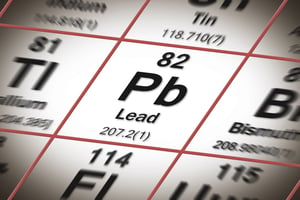Share this
heavy metal toxicity and heavy metal exposure testing: what you should know
by Neoteryx Microsampling on Nov 30, 2020 9:00:00 AM
 While the body needs a small number of heavy metals (zinc, manganese, copper, iron, chromium), buildups of certain metals can be harmful. Such accumulation is known as “heavy metal poisoning” and can be toxic to the body. Here we explore who is vulnerable to heavy metal toxicity and what is involved with heavy metal exposure biomonitoring and testing.
While the body needs a small number of heavy metals (zinc, manganese, copper, iron, chromium), buildups of certain metals can be harmful. Such accumulation is known as “heavy metal poisoning” and can be toxic to the body. Here we explore who is vulnerable to heavy metal toxicity and what is involved with heavy metal exposure biomonitoring and testing.
What are Heavy Metals?
Heavy metals are naturally occurring elements found on the earth and used in modern-day applications, including medicine, agriculture, and manufacturing. They include lead, arsenic, mercury, cadmium, and cobalt. Humans can be exposed to high concentrations of these metals from air or water pollution, medicine, food, and industrial processes, to mention a few.
An accumulation of some heavy metals is toxic, because the metals react with the human body's systems, causing health problems that can range from nervous system dysfunction to gastrointestinal problems. High amounts of arsenic, for example, inhibit the function of a variety of enzymes. Arsenic poisoning can manifest in the form of a brain hemorrhage, muscle aches, seizures, hardening of the skin, bloody diarrhea, and vomiting.
Other metals, such as lead, mimic the molecular composition of calcium, causing enzymes and protein channels that use the nutrient to malfunction as the metal accumulates in the body. High amounts of lead in the body cause various neurological problems, including seizures, confusion, and headaches. Lead is particularly harmful to young children whose brains are still developing.
Causes of Heavy Metal Poisoning
Occupational Exposure
Occupational exposure accounts for a vast majority of heavy metal poisonings. For example, people working in the electronics and manufacturing industries are more likely to experience heavy metal poisoning because they are regularly exposed to heavy metals in the workplace. Workers in the battery manufacturing industry, for example, are regularly exposed to cadmium.
Lead Exposure
Lead can be found in many industries and products. This metal negatively affects children that are exposed to it via paint, especially older paint found in old school buildings and houses. The kids may ingest or chew the paint chips, leading to heavy metal poisoning. In the United States, lead poisoning usually affects kids aged 1-3 years.
Cobalt Exposure
Cobalt toxicity can occur after hip replacement surgery in patients that receive a transplanted prosthetic containing this metal. While cobalt poisoning is a rare occurrence, studies show that medical devices, as in the case of a hip replacement device that contains cobalt, can lead to heavy metal poisoning. Three case studies were performed in 2014 within 10 days of each other to examine the impact of cobalt toxicity after hip replacement surgery.
The patients examined during the study exhibited similar symptoms. Their blood samples revealed high serum cobalt levels. Previous studies showed cobalt toxicity resulted from metal-on-metal implants only, but subsequent research indicated that metal-on-polyethylene implants also can cause heavy metal poisoning.
The researchers found that once the metal in the device wears down, the cobalt is released into the bloodstream, causing toxicity. Patients exhibited symptoms, such as:
- Breathing problems
- Fatigue
- Muscle cramps
- Muscle pain
- Muscle weakness
- Nerve damage in the hands and face
- Poor coordination
- Trouble walking
- Unusual heart rhythm
- Vision changes
The findings prompted the US Food and Drug Administration to recommend follow-ups on asymptomatic hip-replacement patients by performing routine radiographs and physical examinations.
How a Heavy Metal Toxicity Blood Test Can Help
A heavy metal toxicity blood test can reveal heavy metal poisoning. The test determines the level of potentially harmful metals (arsenic, lead, mercury, and cadmium) in the blood. Screening for heavy metal toxicity may also include gathering occupational, dietary, and recreational histories to identify the source of exposure.
How the Heavy Metal Toxicity Test is Performed
The emergence of less invasive specimen collection methods like volumetric absorptive microsampling (VAMS®) with a Mitra® device makes it easier to collect samples for heavy metal blood testing. VAMS technology works with portable Mitra devices that use a simple finger-stick technique, allowing for easy specimen collection at the workplace or remote specimen collection at home. With remote collection, the individual uses a remote health kit like the Mitra® Blood Collection Kit to collect their own sample at home. The samples are mailed to the lab for analysis, and the healthcare team can follow up to provide test results. Some health and wellness companies are also selling home health kits for heavy metal testing that people can purchase independently to get screened for heavy metal exposure on their own.
VAMS has proved to be a reliable method for research studies of heavy metal toxicity, as was shown in a study to determine cobalt toxicity in metal-on-metal prosthesis patients. The sample collection method and extraction procedure provided accurate results independent of the age of the VAMS samples.
Due to the ease and simplicity of using remote, portable specimen collection options for studies in heavy metal testing, future screenings of employees in high-risk work settings or vulnerable patient populations also may leverage kits that include Mitra with VAMS technology.

Share this
- Microsampling (206)
- Research, Remote Research (119)
- Venipuncture Alternative (105)
- Clinical Trials, Clinical Research (83)
- Mitra® Device (73)
- Therapeutic Drug Monitoring, TDM (51)
- Dried Blood Spot, DBS (39)
- Biomonitoring, Health, Wellness (30)
- Infectious Disease, Vaccines, COVID-19 (24)
- Blood Microsampling, Serology (23)
- Omics, Multi-Omics (21)
- Decentralized Clinical Trial (DCT) (20)
- Specimen Collection (18)
- Toxicology, Doping, Drug/Alcohol Monitoring, PEth (17)
- Skin Microsampling, Microbiopsy (14)
- hemaPEN® Device (13)
- Preclinical Research, Animal Studies (12)
- Pharmaceuticals, Drug Development (9)
- Harpera Device (7)
- Industry News, Microsampling News (5)
- Antibodies, MAbs (3)
- Company Press Release, Product Press Release (3)
- Environmental Toxins, Exposures (1)
- July 2025 (1)
- May 2025 (1)
- April 2025 (2)
- December 2024 (2)
- November 2024 (1)
- October 2024 (3)
- September 2024 (1)
- June 2024 (1)
- May 2024 (1)
- April 2024 (4)
- March 2024 (1)
- February 2024 (2)
- January 2024 (4)
- December 2023 (3)
- November 2023 (3)
- October 2023 (3)
- September 2023 (3)
- July 2023 (3)
- June 2023 (2)
- April 2023 (2)
- March 2023 (2)
- February 2023 (2)
- January 2023 (3)
- December 2022 (2)
- November 2022 (3)
- October 2022 (4)
- September 2022 (3)
- August 2022 (5)
- July 2022 (2)
- June 2022 (2)
- May 2022 (4)
- April 2022 (3)
- March 2022 (3)
- February 2022 (4)
- January 2022 (5)
- December 2021 (3)
- November 2021 (5)
- October 2021 (3)
- September 2021 (3)
- August 2021 (4)
- July 2021 (4)
- June 2021 (4)
- May 2021 (4)
- April 2021 (3)
- March 2021 (5)
- February 2021 (4)
- January 2021 (4)
- December 2020 (3)
- November 2020 (5)
- October 2020 (4)
- September 2020 (3)
- August 2020 (3)
- July 2020 (6)
- June 2020 (4)
- May 2020 (4)
- April 2020 (3)
- March 2020 (6)
- February 2020 (3)
- January 2020 (4)
- December 2019 (5)
- November 2019 (4)
- October 2019 (2)
- September 2019 (4)
- August 2019 (4)
- July 2019 (3)
- June 2019 (7)
- May 2019 (6)
- April 2019 (5)
- March 2019 (6)
- February 2019 (5)
- January 2019 (8)
- December 2018 (3)
- November 2018 (4)
- October 2018 (7)
- September 2018 (6)
- August 2018 (5)
- July 2018 (8)
- June 2018 (6)
- May 2018 (5)
- April 2018 (6)
- March 2018 (4)
- February 2018 (6)
- January 2018 (4)
- December 2017 (2)
- November 2017 (3)
- October 2017 (2)
- September 2017 (4)
- August 2017 (2)
- July 2017 (4)
- June 2017 (5)
- May 2017 (6)
- April 2017 (6)
- March 2017 (5)
- February 2017 (4)
- January 2017 (1)
- July 2016 (3)
- May 2016 (1)
- April 2016 (2)


Comments (2)